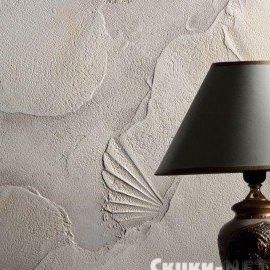
Plaster is different - this is often forgotten during construction and repair work. But its types allow you to both align the walls and create unique coatings of beauty.
The finish, and very decorative and practical, is textured plaster. Due to the ease of application, it is convenient for fans to carry out repairs exclusively do it yourself. Its advantages are both in the unpretentiousness of the evenness of the coating (usually only a primer is required), and in the endurance of the coating. In addition, the end result varies by tools.
The texture of the material is given by inclusions of various grain sizes, which allow achieving unique effects: imitation of velor, cracked porcelain, velvet or silk fabric, stone and other materials. An additional relief can not be created by applying a coating in an even layer, but you can achieve interesting irregularities by varying the pressure, strokes and direction of movement at different angles. Tinting provides additional variety, allowing the use of textured plaster in almost any interiors and exteriors.
Choose the basis
Carrying out both construction cottages outside the city, and apartment renovation, you can completely do without the usual wallpaper, stone cladding and painting. Using textured plaster, you can create beautiful and, most importantly, durable coatings, which are very easy to care for. A reference point in the abundance of the presented modifications will be both information on the features of the model range of a particular manufacturer, and the basis of the stucco mixture.
• Mineral - contains cement. Ideal for wet facade work, vapor permeable, non-combustible. It requires only dilution with water before use.
• Acrylic - contains a mixture of water-dispersed acrylic resins. High climatic stability allows the use of this type of material in a temperature differential. It does not require priming.
• Silicate - made on liquid potash glass.Excellent vapor permeability, but limited color range and fairly high cost. Requires preliminary silicate primer. During restoration or repainting, it is possible to use only silicate or silicone coatings. Ideal for facades in highly humid environments.
• Silicone - the most modern and functional plaster based on silicone resins. An ideal coating for exterior walls near production facilities and large routes - the material repels water and dirt, is excellent in vapor permeability and very durable. But at the same time it is the most expensive of the presented species. It is used only in a duet with silicone primer.
If the scope of silicate and silicone types is clearly defined, then the economical owner is forced to choose between cement and acrylic. It is worth remembering that construction, like decoration, requires only the best materials in terms of parameters and durability, so it is better to prefer acrylic.
It is easier to apply, dries quickly, hardy to wash, which can not be said about cement - washing is contraindicated, and the dirt is well absorbed, and vibration is poorly tolerated. Also the slogan: do it yourself! in relation to mineral textured plasters, it requires considerable skill in tinting (whitish spots, salt precipitations can occur), accuracy in dilution with water and additional costs for color and primer. During storage, a humid environment is excluded. Therefore, ready-made, tinted water-dispersed acrylic compositions are optimal for those carrying out internal repairs of the house and, in some cases, external. You only need to take into account the aggressiveness of the environment and the characteristics of a particular material, as well as its decorativeness, necessary for the implementation of your ideas.
